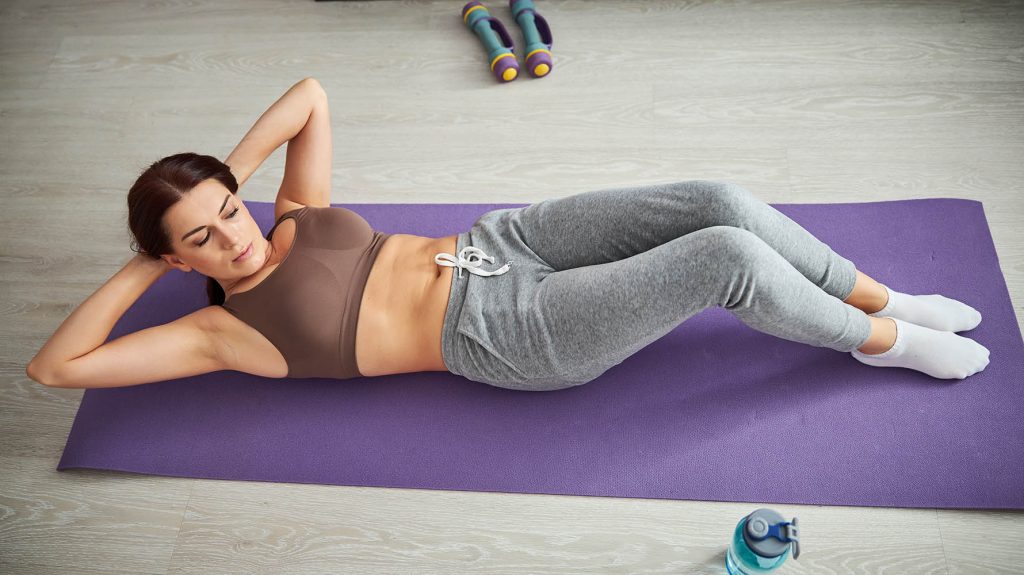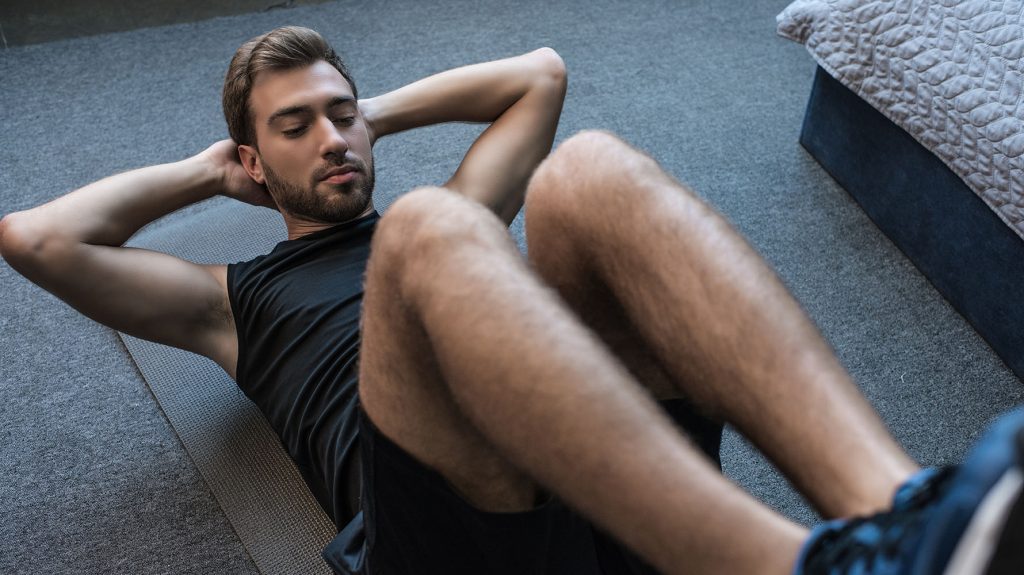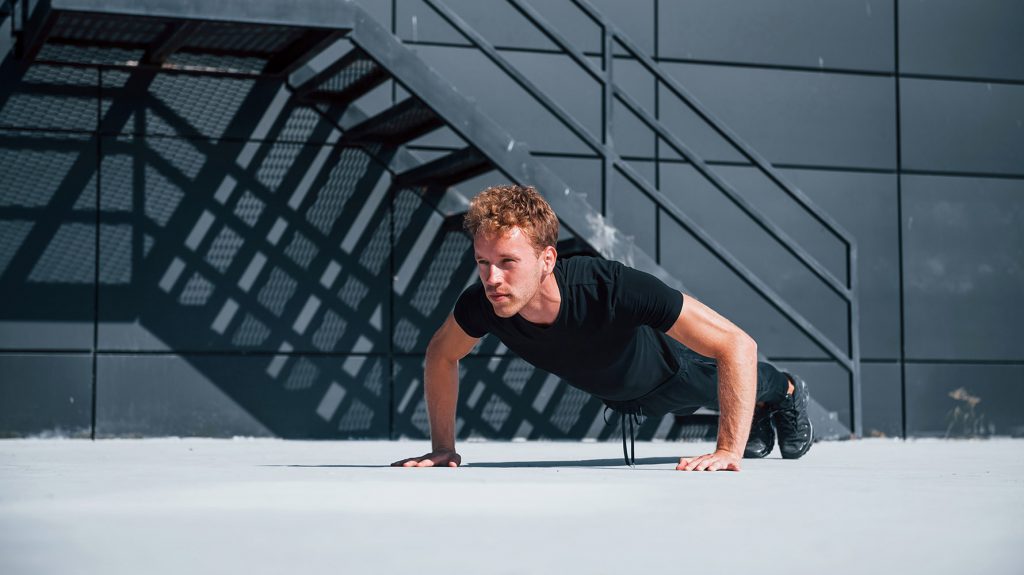There is an old myth, that it is difficult to lose weight and build muscle at the same time, this can be true. However, those who have decided to start exercising are sometimes faced with this problem, of how to build their abdominal muscles up from scratch. Experienced athletes know that a poor exercise technique can lead to back pain and other injuries when trying to achieve this. To help avoid this problem, you can follow the exercise technique we have put together.
Common Abs Training Mistakes Beginners Make
Beginner athletes often do not know how to build their abdominal muscles, especially from scratch, and often make these following mistakes:
- Concentrate on strengthening only the abdominal muscles: Your training should include exercises for all muscle groups, for example, push-ups, squats, crunches, etc.
- Work the abs at the end of a workout: These movements are quite complex, so they need to be done at first within the workout.
- Training daily: However, these muscles need time to recover. It is enough to exercise, at most 3-4 times a week.
- Do not follow the exercise technique properly: By not having a good technique and straining the muscles within the neck or lower back, they do not feel the effects of the exercise within their abs and soon abandon it. Make sure you’re consciously engaging your core muscles (abs) and using them to power you through an exercise, not your neck.
- They do not pay attention to the muscles of the back: These help with the posture needed to allow you to make your posture correct and be able to isolate and target the abs.
- They don’t change the exercises within their routine: The muscles, in this case the abs, get used to the weight load and no longer react to these loads as they did before.
- They buy weight belts for heavy training, but do not end up lifting heavy, which will not strengthen your core due to the belt taking the strain instead.

One of the biggest common mistakes newbies (beginners) make, is a poor diet! Beginners continue to eat fatty foods, fried foods, and at the same time want to get shredded abs and see results. However, when you have a bad diet, even if you have mastered the technique with a good form and are training very hard, you will not get your desired results, as your body is not getting the right fuel source that it needs.
Building a Strong Abs: Where to Begin?
To get a six-pack, you need to learn that the main thing is technique, not the number of repetitions. Even 100 quick crunches with the wrong technique will give you worse results than 10 reps done correctly. The main thing is to understand that during the exercises it is necessary to strain the muscles of the abdomen and isolate them for them to grow.
It is necessary to build an exercise program during which the upper, lower abs and obliques are worked out. Workouts are done 2 to 4 times a week and all movements must be done smoothly, with the abdominal muscles feeling tense, so that you feel the burning sensation within them.
Important! If the exercise is done with poor technique, then tension within the back occurs and this can lead to injury.
First of all, before starting these exercises, you should change your eating habits. It is important to eliminate animal fats, fast carbs, large amounts of salt, sugar, soft drinks and alcoholic beverages. Your diet should consist of proteins, complex carbs and fiber.
It is recommended to combine a good diet with cardiovascular exercises and strength training in order to workout all of these muscle groups. You can start training and growing your abs only after losing some excess fat deposits around this area, this makes it easier to see desired results while training the abdominal muscles.
Abs exercises and growth will not help you obtain a smaller waist. This is only obtained if fat is burned evenly throughout the body. This is done by a person eating properly, with a good diet and exercising regularly.

What Abs Exercises are Recommended for Beginners?
All beginner exercises target different muscle groups. To work out the upper abs, crunches are recommended, for the lower abs, leg raises are recommended and for the oblique muscles, side crunches are recommended. Abdominal exercises for beginners can be done at home or in a gym, this comes down to an athlete’s personal preference.
It is recommended to combine dynamic exercises with static exercises. In the first case, the athlete actively moves to complete these dynamic exercises and in the second, the athlete is fixed in a certain position while completing these static exercises.
When exercises become easy and your body gets used to this load, you can add weights by incorporating dumbbells, or a weight plate to increase this load on the designated muscles.
Abs Exercises at Gym
It is recommended to eat 2 hours before your workout, so that the food you have eaten has had time to be digested before entering the gym. At first when you arrive into the gym, it is recommended to exercise alongside a personal trainer, or somebody experienced within the fitness industry, who can tell you about all of the risks of lifting incorrectly and that can correct your technique if it is needed. Once in the gym and with a good technique while lifting, it is advised to increase the weight load gradually, to avoid sprains and any other injuries that may occur from increasing your weight load.
Most effective beginner exercises in the gym;
- Incline bench crunches. For these, you must lie down on a decline bench (with your feet towards the celling, and your head towards the floor). Place your hands on the back of your head, and while exhaling, gently lift your torso. To make the exercise harder, you can change the incline of the bench so that you have a steeper angle and more length to travel while doing your crunches.
- Swiss ball crunches. Lean on the ball, placing your lower back on the ball, do not lower your buttocks, make sure these stay at the same level as your back. Place your feet flat on the floor, shoulder-width apart. Your hands can be placed on the back of the neck or on your chest (whichever is more comfortable for you) and then lift your torso slowly, but your lower back should remain motionless so that only your abdominals are taking the strain. After completing this crunch motion, you can return to your starting position ready for the next rep.
- Machine ab crunches. Sit on the ab crunch machine which you find in the gym, grab the handles provided above your head. As you exhale, move your arms and legs towards each other. Hold this for 3-4 seconds and then slowly return to your starting position as you inhale.
- Hanging knee raise. Grasp the handles firmly which are usually presented at your shoulder height, press your back against the back of the machine and look forward, it is important to keep a good posture throughout this exercise. Bend your knees and lift them to your chest. Make sure that the body does not sway and lift your knees only at the expense of the abdominal muscles. If the exercise is easy, hold your knees for 3-5 seconds before lowering and continuing with your reps.
- Leg raises. This exercise is performed in much of the same way as the previous one. The difference is that you need to lift with straight legs so that they are parallel to the floor. When you get used to this exercise, this element can be made harder by raising your legs higher than when you start.
These movements will help to make your core strength increase as well as the abs stronger and more prominent. The main thing is to exercise with these regularly and follow a clean well-balanced diet.
Abs Exercises at Home
Even without going into the gym, you can still train your body from home and gain that athletic physique. These effective home exercises described in the table will help you achieve impressive results:
| The exercise | Execution and technique |
| Ab crunches | Lie down on the floor or on a Yoga mat, bend your legs with your feet on the floor, lean on your feet while in an upright position and put your hands on the back of your neck while spreading your elbows. Smoothly lower your body (while keeping the lower back motionless) to reach a position where you are laying on the floor and then raise your body while bending at the hips to bring your torso towards your knees, then lower yourself again and repeat. |
| Side crunches | Lie down flat, again on the floor or a Yoga mat with your knees bent and feet on the floor, when you raise your body, stretch your elbow to the opposite knee. For example make your right elbow touch your left knee, before lowering and then repeat this with the opposite elbow to the opposite knee. |
| Reverse crunches | Lie down and gently raise the lower limbs (legs) so that the angle between them and the floor is 90 °. Then lower your legs, but not completely to the floor so that the abdominal muscles stay tense. |
| V-ups | Lie down and stay in the same position, at the same time raise your upper body and legs, trying to touch them together in a upright seating position. |
| Leg raises | On the floor in the laying position, take turns in raising your right leg and lower and then your left leg and then lower. If the exercise seems too easy, then you can put weighted assistance on your legs to increase the load on the abdominal muscles. |
| Bicycle crunches | Lie on your back and move your legs round in the air as if you were pedaling on a bicycle. |
| Running in place | While standing, bend your elbows at a 90 ° angle and begin to lift your knees, trying to touch the opposite elbow to the opposite knee. |
At home, you can use a piece of equipment called the ab wheel. This is an effective tool that will help you pump and workout your abdominal muscles, which in turn will help them grow faster.
An effective abdominal workout program
A beginner athlete can create his or her own program or they can use the program which is described below. This program helps to strengthen the core muscles through a combination of dynamic and static exercises. You will need to repeat this exercise 3 times a week.
- Side plank – Using your elbows and legs, lay in a fixed position on the floor, first on your right side and then your left side and hold this for 20 to 30 seconds per side. This is repeated three times so that you complete 3 sets of this exercises.
- Elbow to knee crunch – This exercise is completed using 20 to 30 reps for each side and repeated for 2-3 sets. Lie down and put your right foot on top of your left foot. Place your left hand on the back of your neck. Try to touch your elbow on the opposite knee (right knee) this is repeated using the opposite elbow to the opposite knee.
- Side crunches – This exercise has 5-7 reps and 3 sets. Lie on your side while having your whole body touching the floor and then lift your upper body, squeezing the obliques and hold for 1 to 2 seconds before releasing.
- Scissor crunch – This has exercise has 10 to 15 reps and 3 sets. This is performed the same as explained above.
- V-ups. Hold at the top point for 10-20 seconds and repeat this three or four times.
- Reverse crunches – These are done at 10 to 15 reps with 3 sets.
- Ab crunches – These are completed with 7 to 15 reps and 3 sets.
- Stretching the arms and legs. Get on all fours, extend your right arm and left leg out so that you feel the stretch within your core and hold for 10-20 seconds. Then do the same with your left arm and right leg. This is repeated three or four times for each side.
Perform all exercises slowly, preferably without music so that you can concentrate on your muscles, breathing and pace of the exercise.
If you regularly perform this complex routine for one month, you can tighten your stomach, strengthen your core and make your muscles more defined.
Tip from a Professional Trainer
According to leading fitness trainers, in order for a beginner to pump their abdominal muscles efficiently, they need to improve their routine. We are talking about a balanced diet, a combination of strength and cardiovascular exercises. After all, if a beginner athlete eats fatty, fried foods, then the abdominal muscles will not be visible under the layer of fat which we explained above. After losing fat deposits through good diet and exercise, they can start some serious training and increase their exercises to get that desired six-pack and solid core.
Jay Cardiello, Professional Trainer
Jay Cardiello, a personal trainer to countless celebrities and professional athletes, highlighted the basic rules and a few tips for building a beginner’s abdominal muscles;
- Do a new exercise every 4 to 8 weeks as the muscles get used to the load provided and will not respond as well to growth.
- Do not pull and put strain on your head during crunches, as this can lead to neck injuries.
- Control the pace of breathing: while inhaling, relax, and while exhaling, tense your muscles.
- Perform movements slowly and efficiently.
- At the highest point of an exercise, tense your muscles and squeeze as much as possible to feel a burning sensation, this helps with muscle growth.
And lastly to try and keep your muscles tense throughout your workout and during the last repetitions, this is when the muscle fibers break, which provokes their growth and their increase in volume when repaired.
Dan Trink, C.S.C.S., a strength coach and trainer gives his tips
Dan advises to switch to more intense exercises after a month of regular training such as; captain’s chair leg raises, ab wheel exercises and weighted exercises. If this doesn’t give visible results, then try supersets. To achieve greater results, include cardio within your workout, which accelerates fat burning and allows you to build muscle definition faster. To do this, alternate, for example, leg raises with the mountain climber. Rest less between sets. After 8-10 supersets, you will notice a change due to the intensiveness of this exercise.
Lee Boyce, trainer; Lee’s tips
A functional training specialist claims that in order for a beginner to build a six-pack, he must follow these rules;
- During training, you need to move smoothly, tensing only the abdominal muscles.
- Create a calorie deficit, which means eating less than you burn.
- Do cardio workouts three times a week.
- 2-3 times a week target all abdominal muscle groups.
Although these tips become very similar throughout our advice and those of others, it is noted that these are key factors towards the goals that you are looking for and the desire for that solid core and those promoted hard abs! If these rules are followed, the beginner will start to notice these first results after only 4 weeks.
Main conclusions
As you can see, it is possible to build your abdominal muscles from scratch if you stick to the following plan:
- If you are overweight, change your eating habits and diet.
- Create your own training program or exercise with a trainer in the gym.
- During your abs workout, tense only your abdominal muscles, not your neck or back.
- Move smoothly, watch your breathing: exhale – tension, inhale – relaxation.
- Combine abs with cardio loads.
- Include movements to work out the upper, lower abs and obliques.
- Combine static and dynamic exercises.
Train regularly, follow your routine, eat healthy with a good diet and within one month you will achieve impressive results!


